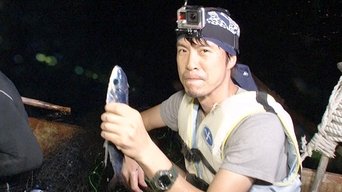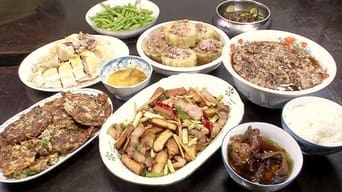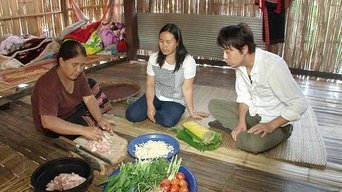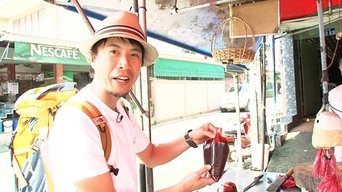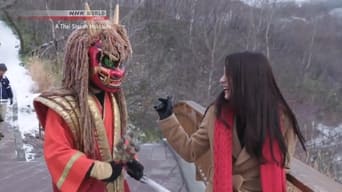15 Minutes Season 1

Content on-the-go! Diverse, innovative, immersive and smartphone optimized. Topics range from arts, crafts and ninjas to international celebrities!
Watch NowWith 30 Day Free Trial!
15 Minutes
2018
Content on-the-go! Diverse, innovative, immersive and smartphone optimized. Topics range from arts, crafts and ninjas to international celebrities!
Watch Trailer
15 Minutes Season 1 Full Episode Guide
The ninja were often given the important mission of infiltrating enemy territory and bringing back key information. Meanwhile, their own residences were cleverly rigged to thwart intruders and hide the information they'd acquired. In this episode, we'll examine the secrets of their residences, including trap doors, lookout posts, sword compartments, and hanging ladders, using action-packed reenactments. We'll also examine the psychological effect of these residences.
The ninja employed over 400 special weapons and tools to accomplish their missions, and the shuriken is undoubtedly one of the most famous. In this episode, we'll examine not just how the shuriken was thrown, but ninja techniques for throwing it with a string attached, and using it defensively. The ninja also devised various throwing techniques such as "yoko-uchi," "hon-uchi," and "gyaku-uchi." We'll use cutting-edge science to examine their uses, and use the shuriken to draw closer to the ninja truth.
The Japan Folk Crafts Museum in central Tokyo, established over 80 years ago, collects tableware and clothing used in everyday life. Made by nameless craftsmen, the objects on display in its galleries suggest a hidden beauty within the practical. The entire building was designed carefully so as to convey the warmth and comfort of traditional Japanese life. The folk crafts on display there represent the diverse lifestyles in many different areas of Japan.
RAKUGO NIPPON! IWATE is a show that follows Rakugo performers' journey to Iwate on a journey to discover all of Iwate's autumn flavors.
RAKUGO NIPPON! IWATE is a show that follows Rakugo performers' journey to Iwate on a journey to experience the age-old culture of Tohoku.
The Aomori Museum of Art was built next to ancient ruins dating back some 5,000 years. The museum's architectural style is quite unique, reflecting the image of the nearby excavation site. The interior is laid out like a maze, letting visitors view artwork as they find their way through their peculiar surroundings. An approximately 3-hour bullet train ride from Tokyo, Aomori Prefecture is a region known for rich nature and harsh winters. This land has given birth to numerous works of art that are highly representative of this region. The museum has put particular effort into the collecting the works of local artists, allowing visitors to come into contact with special artwork the likes of which cannot be seen anywhere else.
The history of Kyoto Wire Weaving goes back more than 1,000 years. Used as kitchen utensils in Kyoto cuisine, these tools have been cherished by chefs and people in the city through the generations. Kana-ami weaver Kenichi Tsuji and his son, Toru keep the wisdom and experience of the past alive. Their goal is to produce handmade tools fit into contemporary lifestyles.
The Museum of Modern Art, Wakayama, located 40 minutes from Kansai International Airport, sits right beside Wakayama Castle, and reflects the castle's design in its architecture. Half of its 14,000-piece collection consists of Japanese print art. This episode follows the revolutionary techniques and bold lives of historic print artists. These prints, as well as depictions of the rich local nature, introduce artists from Wakayama Prefecture and their contributions to the history of modern art.
Sisters 69-year-old Akemi and 67-year-old Satsuki have embraced "shojin ryori," a kind of vegetarian cuisine practiced by Buddhist priests. What might seem a strict diet has evolved into a project of passion. The sisters have spent 2 decades cooking up a wide repertoire of delicious recipes, which they now share at cooking classes. This program follows preparations for one lesson, and how, through "shojin ryori," they've come to deepen their understanding of themselves and the world around them.
The Hoki Museum is home to paintings that are strikingly similar to reality. Some 500 works by modern Japanese artists are exhibited in this museum located in Chiba Prefecture, just a 1-hour train ride from Tokyo. This episode focuses on the works of 5 artists, whose art spans various subjects including a bird nest, the female form and country landscapes. But rather than pursue just photorealism, each artist of the museum articulates their own unique perspectives through their works.
RAKUGO NIPPON! CHICHIBU is a show that follows Rakugo performers' journey to the magnificent nature of CHICHIBU, where heart-moving experiences are turned into original English Rakugo performances.
RAKUGO NIPPON! KAMAKURA is a show that follows Rakugo performers' journey to tradition and nature rich KAMAKURA, where heart-moving experiences are turned into original English Rakugo performances.
The 21st Century Museum of Contemporary Art, Kanazawa was built on an idea that the museum should be like a neighborhood park open for everyone. Many up-and-coming artists offer their talents for creating works that bridge tradition and modernity, which match the city with a 400-year history of bringing and fostering new culture. You will also enjoy the charm of the ancient city, Kanazawa, which did not suffer war damage and maintains its traditional townscape.
Ninja are now seen in popular media around the world. But as their profile rises, their reality gets muddied amid legends and fantasies. The truth about authentic ninja lies unknown, shrouded in mystery. This program carefully examines the fighting skills and tools used by actual ninja, and conducts experiments to determine the "Ninja Truth". The ninja used short swords when faced with imminent danger, such as in enemy territory. We'll see when these were used, and how they differed from warrior's katana swords. Also, ancient ninja literature describes a water-crossing device known as "mizugumo". We'll do an experiment, constructing "mizugumo" exactly as described, to see if it really worked. And we'll get a ninja expert's opinions about how it could be improved today, and try that too! Join us to see the results!
Ninja are now seen in popular media around the world. But as their profile rises, their reality gets muddied amid legends and fantasies. The truth about authentic ninja lies unknown, shrouded in mystery. This program carefully examines the fighting skills and tools used by actual ninja, and conducts experiments to determine the "Ninja Truth". The ninja had over 400 distinctive tools and weapons to fight with and defend themselves. The most familiar was one called the "kusari-gama", a chain and sickle that could do serious damage to an opponent. But it raises questions about how they used it when fighting, and how they were able to conceal it. The ninja were also ingenious at hiding themselves. We'll do an experiment to see if those hiding techniques really worked, and we'll look at a brand-new technology for hiding people.
Culinary specialist Kentetsu Koh travels across Asia in search of great home cooking and person-to-person encounters. In this episode, Kentetsu goes to Taiwan's Orchid Island, known for its coral reefs. There, he tries the native Tao people's tradition of fishing for flying fish. For the Tao people, the flying fish is sacred. So, they follow strict rules on how to prepare and eat it. Nothing goes to waste. Dried flying fish is first used to make soup. Then, what's left is cooked with fried rice. Kentetsu tastes the dishes with respect and gratitude.
Culinary specialist Kentetsu Koh travels across Asia in search of great home cooking and person-to-person encounters. When Kentetsu explores Taipei, he comes across a fragrant cup of tea. This leads him to a tea farm in an area called Beipu. At the home of a Hakka family, he's treated to a tea called Oriental Beauty. It is grown in a way that allows bugs to sweeten it up by chewing on the leaves. Kentetsu also tries some authentic Hakka dishes made from preserved ingredients such as mustard greens that have been fermented more than 3 months and dried white radish that's been aged 5 years. Join him as he experiences a diversity of tastes and lifestyles.
Culinary specialist Kentetsu Koh travels across Asia in search of great home cooking and person-to-person encounters. In the Thai town of Mae Ai, near the border with Myanmar, Kentetsu meets a woman of the Lahu ethnic minority and learns about their traditional dishes. He helps make one of them: meatballs flavored with, of all things, tree shavings. Farmers prepare it as an offering during harvest. Then he learns how to make a rice gruel the Lahu people always cook when they welcome guests. He finds out it takes a good bit of time and effort.
Culinary specialist Kentetsu Koh travels across Asia in search of great home cooking and person-to-person encounters. Join him as he experiences a diversity of tastes and lifestyles throughout the region. In this episode, Kentetsu tries a Thai dish that uses pig's blood, a specialty of Mae Sai, Thailand's northernmost town on the border with Myanmar. He visits the catering shop of a woman he met at the market and watches her cook the stir-fried dish, which includes both the blood and minced pork.
This program portrays artisans who make traditional crafts, artistic or industrial products or luxury items. They use what the local climate offers them to create lifestyle products. Our camera will follow them to capture the process of how "Treasured Creations" are made. Our 1st episode will feature a "bamboo basket" made from a special bamboo grown only in the Awa region of Kochi Prefecture on Shikoku. It was originally known as a "tofu basket" and was used to carry tofu home after being bought from a local store. We observe as a bamboo craftsman demonstrates the traditional techniques as he heats to change the color, bends to straighten nature's curves, and weaves bamboo sticks together to transform it into a masterwork of nostalgia.
This program delves into traditional recipes to shine a light on unique food cultures across Japan, and discover the older generation's seasoned philosophies of life. Tami Hiyama, 92 years old, lives alone in Fukuoka City, where she has taught home cooking for more than 60 years. We learn her recipe for "chirashi-zushi," a special kind of sushi eaten at family celebrations. Tami prepares the finest ingredients but she says mindset is just as important -- she cooks the dish imagining those who will soon enjoy it. What does "chirashi-zushi" mean to 92-year-old Tami? We discover her recipes for life and the secrets of her good health.
This time, we continue our winter journey to Hokkaido, the setting of hit Thai film One Day, with its star Nittha Jirayungyurn, also known as Mew. First, to a hot spring resort with a surprising name where Mew takes in breathtaking views. Next, to Sapporo, Hokkaido's largest city, where she discovers classic Japanese toys, chomps down on soul food and learns winter survival tips from locals. Finally, to a key location from One Day, a chapel that's a romantic must-see spot for fans of the film.
Thanks to their appearance in hit Asian films, locations throughout Japan are being thrust into the spotlight. Previously unknown to most travelers, these locations are now must-see spots for movie buffs from both in and outside Japan. We visit these new tourist hotspots with the stars of the films that made them famous, hearing the behind-the-scenes stories of those hit movies. Plus, an inside look at what makes each location special, including local places, faces, food, history and more. This time, a winter journey to breathtaking Hokkaido, the setting of hit Thai film One Day, with its star Nittha Jirayungyurn, also known as Mew. First, to a ski resort, where you can enjoy the top-quality snow for close to half the year, and to a romantic spot featured in the film. Other highlights include an ice restaurant where Mew tries a unique dish, a collection of over 25,000 music boxes, a reunion with a shopkeeper Mew met while filming One Day, and a special slow food unique to Hokkaido.
Softpomz from Thailand experiences the life in the deep snow of freezing Gokayama, a World Heritage Site where residents spend their winters in snow over 2 meters deep.
Softpomz from Thailand dives into the behind the scenes of the ultimate Ekiben. Will she be able to convey the ekiben staff’s passion to the customers?
Do you know "Rakugo"? Along with Kabuki, it's a traditional Japanese entertainment of dexterous and comical storytelling that covers everything from people's everyday lives, customs, food to unique sceneries. On "RAKUGO NIPPON!", we follow the travels of Rakugo performers in the beautiful land of Japan, and discover how they transform their heart-moving experiences into original English Rakugo performances. This episode will follow English Rakugo Performer Kimie Oshima to Toyama Prefecture, where local splendors such as the Winter Yellowtail of Himi and the traditional cast metal crafts of Takaoka await her. Just what kind of original Rakugo will her journey usher? Sit back and enjoy!
Free Trial Channels
Seasons





















